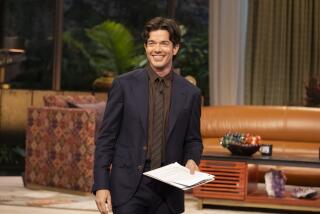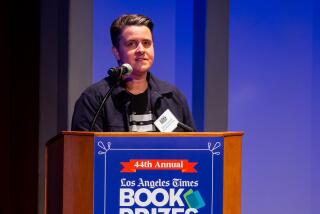Judged by the cover no more
“To speak from a particular place and time is not provincialism but part of a writer’s identity,” insists poet Dana Gioia, who proudly claims the mean streets of Hawthorne as his birthplace. “It is my pleasure and my challenge to speak from California.”
Gioia’s words offer a rare moment of unembarrassed affirmation in “The Misread City,” an illuminating but also intentionally provocative anthology edited by Gioia and Scott Timberg. More often, the poems, essays, profiles and critiques collected here are edgy and demanding or, as the editors put it, “speculative and argumentative.”
“Our goal is to celebrate the Southland,” the editors insist, “without becoming blindly uncritical.”
Most of the 34 selections in “The Misread City” were first published over the last several years in various magazines and newspapers, including L.A. Weekly, New Times and the Los Angeles Times. Some are longer book excerpts, including a magisterial chapter on the apocalyptic tradition in Los Angeles fiction from David Fine’s admirable study, “Imagining Los Angeles: A City in Fiction.” A few of the best pieces appear to have been written especially for publication in “The Misread City,” including Laurence Goldstein’s “City of Poems: The Lyric Voice in Los Angeles Since 1990.”
“Now it’s time to remember that Karl Shapiro called Hollywood ‘a possibly proud Florence’ back in 1941, and that even earlier Vachel Lindsay was proclaiming Los Angeles as the site of a renaissance of wonder,” writes Goldstein. “As the poets of Los Angeles gradually rescue their city from the mortmain of stereotype and situate it, newly-discovered, in our consciousness, we may find it as familiar, and as strange, as our own transfigured neighborhoods.”
Virtually all of the iconic writers of contemporary Los Angeles are revisited and reevaluated in “The Misread City,” including such diverse but essential literary figures as Carolyn See and John Rechy, Charles Bukowski and Wanda Coleman, Kevin Starr and Mike Davis. Sometimes the tone is critical and even carping, sometimes gossipy, sometimes reverential and occasionally all three at once, as in Timberg’s profile of Rechy, “The Romantic Egotist.”
“Writers since Whitman have spoken of the need for raw, lived experience -- all kinds of it -- to power good writing,” observes Timberg. “... If living well is the best revenge, Rechy should be a happy man indeed.”
A good deal of time and space in “The Misread City” is devoted to the usual gang of suspects, including a lineup of hard-boiled mystery writers ranging from Dashiell Hammett and Raymond Chandler to James Ellroy and Walter Mosley, all of whom are dutifully praised. At its best moments, however, the editors offer rather more surprising insights into who matters in Los Angeles letters.
Thus, for example, Ray Bradbury is credited for literary achievement that transcends the category of science fiction: “Both ‘Fahrenheit 451’ and ‘Martian Chronicles’ can be read as refracted commentaries on California life and culture,” Gioia and Timberg point out. And Aimee Bender, author of “The Girl in the Flammable Skirt,” is singled out as an “unflinching newcomer [who] seems like a great young hope” by Sara Scribner. “It makes sense that Bender grew up in Los Angeles,” writes Scribner. “Her stories capture the experience of living in a slightly battered absurdist parade.”
Then, too, “The Misread City” finds its way to people and places that often go unremarked in books that claim to cover literary Los Angeles. Among many others, we hear from and about Doug Dutton of Dutton’s Books and Glenn Goldman of Book Soup, KPCC broadcasters Larry Mantle and Kitty Felde and KCRW broadcasters Warren Olney and Michael Silverblatt, all of whom figure importantly in introducing authors and their books to a Southern California readership. And David Kipen, the lively book critic of the San Francisco Chronicle, introduces us to “eleven reliably gifted contemporary screenwriters” in “Auteurism’s Great Snow Job” -- and explains why we should know them.
“[T]he smartest people in Hollywood are the screenwriters,” he points out, “who have even less power than esteem, and too often less self-esteem than either.”
Among Timberg’s three contributions to “The Misread City,” all of which first appeared in the now-defunct New Times, is a mostly fault-finding piece on the Los Angeles Times Book Review. But Timberg, who now works for The Times, backs off a bit from his criticism in the preface to the book: “The Los Angeles Times Book Review,” the editors write, “has now steered decisively toward writers and topics of Southern California.”
The editors never really explain why they regard Los Angeles as a “misread” city, although the title suggests that they believe that some readings are correct and some are not. Gioia himself, now famously serving as chairman of the National Endowment for the Arts, is rigorous when it comes to the art of poetry: “You can’t have great literature without great standards,” he is quoted as saying in one of the contributions to “The Misread City,” “and no one wants to hear this, especially in L.A.”
Elsewhere in “The Misread City,” however, Gioia and Timberg readily concede that they provide the reader with “no unifying abstraction” to use as a benchmark of excellence in arts and letters. Rather, they compare their book to “a good museum group show,” and they insist that their goal “was not to be definitive or timeless but rather, to be culturally useful -- informed, thoughtful and contemporary.” At that mission, so modestly stated, they have succeeded magnificently.
More to Read
Sign up for our Book Club newsletter
Get the latest news, events and more from the Los Angeles Times Book Club, and help us get L.A. reading and talking.
You may occasionally receive promotional content from the Los Angeles Times.








